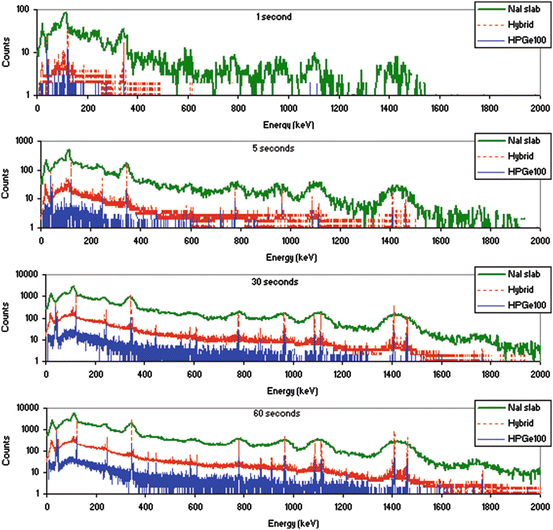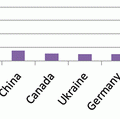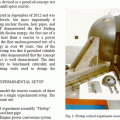Fig. 20.1
Example hybrid detection system processing, with a large NaI(Tl) and HPGe detectors
The process of combining the hybrid system spectra first requires separating peak counts from scattered continuum counts. This separation is performed using standard baseline estimation. The respective continua are then separately rebinned and summed to a common energy calibration. The peak spectra are also rebinned to the common energy calibration but are further processed prior to adding to the final spectrum. The processed, hybridized peak spectra are combined with the previously generated continuum spectrum to produce the final output spectrum. The output spectrum has a peak shape calibration similar to the better resolution constituent detector but with peak counts from both detectors. The hybridization process only redistributes measured counts. Counts are neither created nor destroyed but are explicitly conserved. The process does not attempt to recoup scattered counts into photopeaks and so is only effective for spectroscopy detectors with significant peak responses. Since the hybrid spectrum reflects a correlation of peak responses among the constituents, all of the constituents should have similar sensitivities to be most effective across the largest dynamic range. If both detectors do not have a peak response, they will not resonate. A standard system of like detectors combines constituent spectra after matching energy calibrations. Energy calibrations might be matched by adjusting hardware settings such as amplifier gain, but variations in non-linearities and offsets limit the accuracy of this approach. More commonly, each spectrum is energy calibrated separately and is then rebinned to a common energy calibration. The rebinning process does include the introduction of some additional uncertainty. However, experience has shown that the benefits outweigh this small degradation in precision. The hybridization process also manipulates the raw spectral data, but to a greater degree effective across the largest dynamic range. If both detectors do not have a peak response, they will not resonate. A standard system of like detectors combines constituent spectra after matching energy calibrations. Energy calibrations might be matched by adjusting hardware settings such as amplifier gain, but variations in non-linearities and offsets limit the accuracy of this approach. More commonly, each spectrum is energy calibrated separately and is then rebinned to a common energy calibration. The rebinning process does include the introduction of some additional uncertainty. However, experience has shown that the benefits outweigh this small degradation in precision. The hybridization process also manipulates the raw spectral data, but to a greater degree than merely rebinning to a common calibration, incurring relatively greater additional uncertainties. One goal of this study is to demonstrate that the process of hybridization can provide a net benefit, at least for the system studied.
20.2.1 Measurements
A series of measurements were performed with a variety of sources over a range of acquisition times using the HPGe100 and NaI slab detectors. The sources included 241Am (60 keV), 133Ba (81, 276, 303, 356 and 384 keV), 137Cs (662 keV), 60Co (1,173 and 1,332 keV) and 152Eu (122, 245, 344, 411, 444, 779, 867, 964, 1,086, 1,112 and 1,408 keV). These were acquired with both detectors at the same source-to-detector distances for live times of 1, 5, 30 and 60 s. Each of these live time acquisitions were repeated ten times. In addition to the individual detector spectra, associated spectra were combined to produce hybrid system spectra. Each spectrum was analyzed to obtain all of the found peak areas as well as underlying continuum backgrounds. The figure of merit for each peak was determined in accordance with Eq. (20.1):

Such figures of merit are intended for relative comparison between the significance of peaks found for the individual detectors and the hybrid combination. Figure 20.2 shows an example of the progression of 152Eu spectra over the measured live times.


(20.1)

Fig. 20.2
Hybrid system measurements of 152Eu for live times of 1, 5, 30, and 60 s, from top to bottom
The measurements have also been used to benchmark simulations to provide validation of a more comprehensive assessment of a hybrid system through simulations. The simulations have been generated using response functions derived from Monte Carlo N Particle (MCNP) software [4] combined with respective background measurements.
20.2.2 Performance Evaluation
Ultimately, the performance of a security system depends on the accuracy of identification results over the full range of likely sources and acquisition times [5]. The activities are specified for point sources at a distance of 1 m. The sources include naturally occurring, medical, industrial and special nuclear materials. Each of these nuclides was modeled individually and all unique pairings, for a total of 325 simulated spectra for each detector and each live time. The acquisitions were modeled for live times of 3, 10 and 30 s. The detectors modeled were a single NaI slab, a single HPGe100 and two HPGe100 (HPGe200). Hybrid spectra were then derived by combining HPGe100 and the NaI slab (Hybrid100) and combining HPGe200 and the NaI slab (Hybrid200). The performance evaluation proceeded by analyzing each spectrum with standard nuclide identification algorithms. For the HPGe100, HPGe200, Hybrid100 and Hybrid200 spectra, the analyses used were standard Canberra Genie4 peak search, interference corrected analysis engines, with the only variation being the use of appropriate respective backgrounds for background subtraction.
The NaI slab analyses were performed using Genie’s Library Correlation NID5 analysis engine, more appropriate for lower resolution detectors.
Stay updated, free articles. Join our Telegram channel

Full access? Get Clinical Tree






